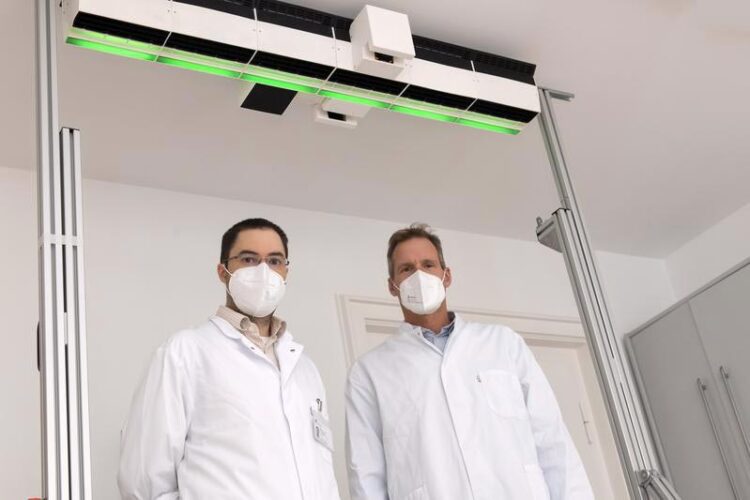Invisible virus protection for indoor spaces

PD Dr. med. Arne Wieser (l.), Division of Infectious Diseases and Tropical Medicine, LMU University Hospital Munich, and Prof. Dr. Christoph Haisch, Lasers and Microparticles Lab, Technical University of Munich.
Credit: Steffen Hartmann / LMU University Hospital Munich
Room divider based on UV-C light inactivates SARS-CoV-2 aerosols.
Despite myriad precautionary measures, virus-contaminated aerosols still pose a serious problem indoors. An invisible protective wall of UV-C light developed by researchers at the Division of Infectious Diseases and Tropical Medicine at the LMU University Hospital Munich and the Technical University of Munich (TUM) could provide a solution and reliably curb the spread of viruses and other pathogens in rooms in the future while allowing total freedom of movement.
A research team from the Division of Infectious Diseases and Tropical Medicine at the LMU University Hospital Munich and the Technical University of Munich, in cooperation with the start-up Smart United GmbH, has developed an invisible protective “wall” made of UV-C light.
In their study, published as a preprint on medRxiv, the researchers were able to demonstrate that the UV-C virus barrier they developed can prevent the spread of airborne pathogens indoors by killing the pathogens traveling along on the aerosol particles.
The protection rate was verified using model organisms, including E. coli, S. aureus, and a coronavirus. Inactivation rates of over 99 percent were achieved at air velocities of 10cm/s.
Twofold protection system eliminates over 99 percent of pathogens
“Our system can be suspended from the ceiling like a lamp to subdivide rooms. The UV-C light radiates downward in a focused manner. As with a protective curtain, pathogens are inactivated as soon as they “float through” the barrier while piggybacking on aerosol particles,” explains the private lecturer Dr. med. Andreas Wieser, a specialist in microbiology, virology and infectious disease epidemiology at the Division of Infectious Diseases and Tropical Medicine at the LMU University Hospital Munich.
Professor Christoph Haisch from the Department of Analytical Chemistry and Water Chemistry at the Technical University of Munich adds: “In addition, the system with its patented protective mechanism disinfects breathing air in the room by drawing it in and slowly blowing it into the light-exposed area of the UV-C light wall. This, in combination with the direct barrier effect of the light wall, effectively prevents the accumulation of infectious aerosols in the room.”
Safe virus dispersion suppression for small and large areas
Special shut-off devices ensure that the system’s UV-C light poses no health risks. As soon as an object or body part enters the radiated area, the source is automatically switched off. This also applies when people pass through the light curtain, allowing total freedom of movement.
Applicable requirements for occupational health and safety, including the strict exposure limits for UV radiation specified and other legal requirements, are fulfilled thanks to innovative specialized optics. In addition, the innovative LED light source and the special optics prevent ozone formation.
The UV-C virus barrier can be used as an invisible room divider to segment large rooms into smaller “virtual” air-insulated rooms. This allows the system to be deployed as an essential part of aerosol hygiene concepts in rooms and buildings.
“We are currently doing everything imaginable to bring our virus protection walls to market as quickly as possible,” says Reiner Prohaska, Managing Director of the cooperation partner Smart United. “Alongside the scientific validation of the system, we have started preparing production with well-known suppliers in the automotive industry. Starting in early January, we will commence space planning with our first customers. In April, we will deliver the first UV-C light virus protection walls – with the goal of returning a piece of normality to people’s lives.”
More information
The research was funded by the German Federal Ministry of Education and Research (BMBF) and the German Center for Infection Research. Smart United GmbH provided materials and technical support.
Wissenschaftliche Ansprechpartner:
PD Dr. med. Andreas Wieser
Division of Infectious Diseases and Tropical Medicine,
LMU University Hospital Munich | Max von Pettenkofer-Institut
Tel.: +49 89 2180 78 296
E-mail: wieser@mvp.lmu.de
Web: http://www.klinikum.uni-muenchen.de/Abteilung-fuer-Infektions-und-Tropenmedizin/…
Prof. Dr. Christoph Haisch
Lasers and Microparticles Lab
Technical University of Munich
Tel.: +49 89 2180 78 242
E-mail: haisch@tum.de
Originalpublikation:
Aerosol decontamination and spatial separation using a free-space LED-based UV-C light curtain
Andreas Wieser, Jessica Beyerl, Albrecht v. Brunn, Vincent Rieker, Marcus Rieker, Michael Hoelscher, Christoph Haisch
Available as preprint at: https://doi.org/10.1101/2021.12.16.21267937
Media Contact
All latest news from the category: Medical Engineering
The development of medical equipment, products and technical procedures is characterized by high research and development costs in a variety of fields related to the study of human medicine.
innovations-report provides informative and stimulating reports and articles on topics ranging from imaging processes, cell and tissue techniques, optical techniques, implants, orthopedic aids, clinical and medical office equipment, dialysis systems and x-ray/radiation monitoring devices to endoscopy, ultrasound, surgical techniques, and dental materials.
Newest articles

Innovative 3D printed scaffolds offer new hope for bone healing
Researchers at the Institute for Bioengineering of Catalonia have developed novel 3D printed PLA-CaP scaffolds that promote blood vessel formation, ensuring better healing and regeneration of bone tissue. Bone is…

The surprising role of gut infection in Alzheimer’s disease
ASU- and Banner Alzheimer’s Institute-led study implicates link between a common virus and the disease, which travels from the gut to the brain and may be a target for antiviral…

Molecular gardening: New enzymes discovered for protein modification pruning
How deubiquitinases USP53 and USP54 cleave long polyubiquitin chains and how the former is linked to liver disease in children. Deubiquitinases (DUBs) are enzymes used by cells to trim protein…



